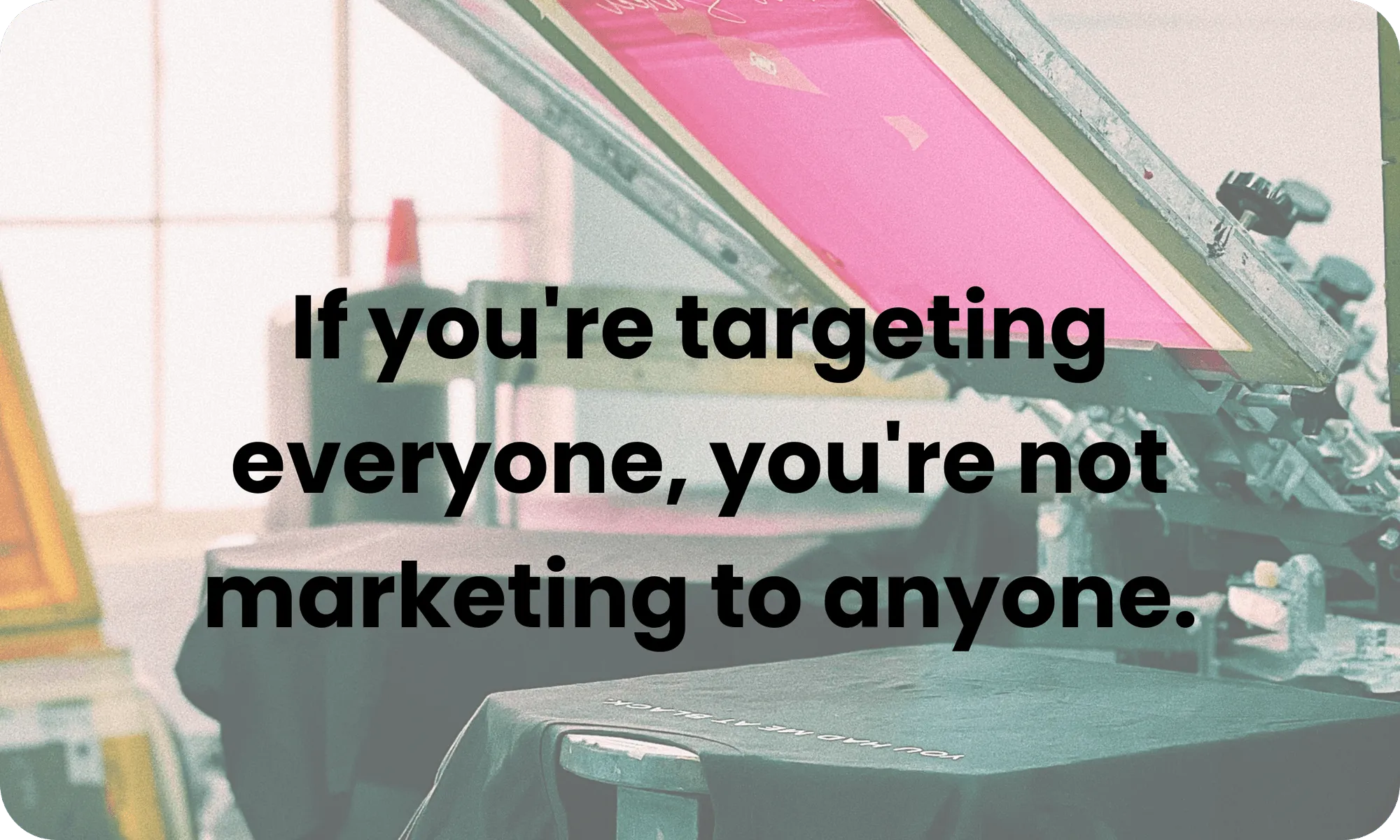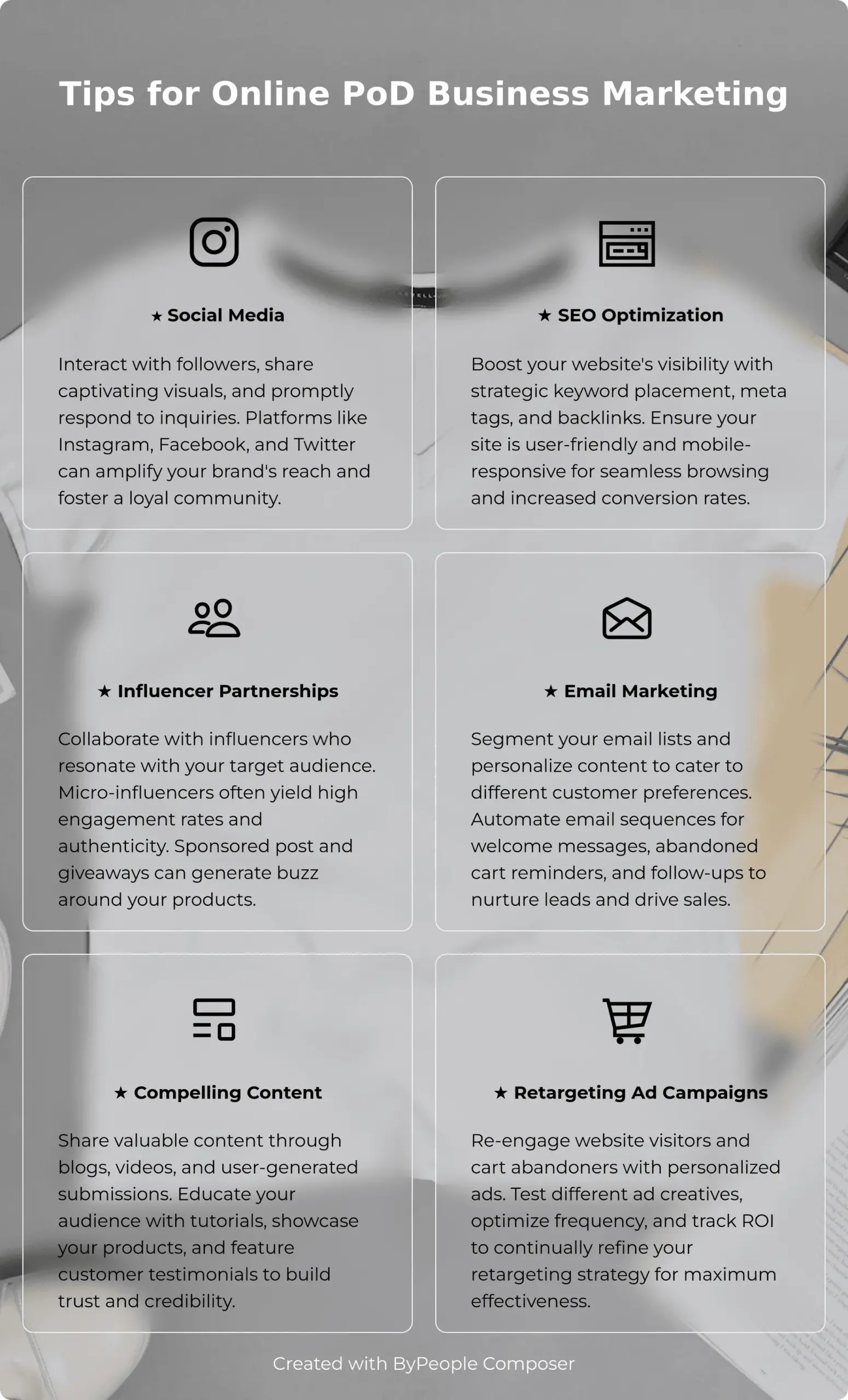Marketing Tips for Your Print on Demand Business Online and Offline

Starting a print-on-demand company, like any other, can lead to either success or failure. My parents, who used to work for external companies, decided one day to open their own. However, their lack of education in digital marketing and marketing itself put them at a disadvantage compared to other businesses with the same business model. Learning the necessary strategies to establish a brand in the market is essential for success and avoiding failure.
To be successful in any entrepreneurial endeavor you need to have a strong marketing strategy, and the Print on Demand industry is no different. While your customer service and product quality will go a long way to help you build a relationship with your customers and keep them coming back for more, you’ll need to develop the right strategy in order to maintain a steady growth and stay competitive. If you are not sure where to start, we’ve got your back.
That’s why having a consistent brand identity is a big part of marketing a business online and offline. If you have the products but don’t have a clear vision of how to keep your online content consistent, you can check out our Social Media Templates collection where you’ll find comprehensive sets of editable templates that you can use to create social media and print content easily!
Now, let’s go with the tips.
Define Your Target Audience and Niches

The most effective first step you can take to begin setting up your marketing for success is figuring out two things: your target market, and your target audience.
Both of these terms refer to specific groups of people, however, there’s a few key differences between these concepts:
- Target Market: the broader group of people you’re planning to target with your products, who may share several characteristics such as age, occupation, gender.
- Target Audience: is a narrower, more specific subset of people within your target market. These are the groups of people you’ll want to target with specific ad content and marketing campaigns, sharing similar characters as those found in your target market, but also other, more specific characteristics such as location, subculture and search interests.
Having a clear idea of who are the people you are trying to reach with your products will give you a solid foundation to build your marketing efforts on, and is essential to any successful marketing effort. After all, you can’t sell products or services if you don’t know who’s interested in buying them to begin with.
This first step will set the tone for the performance of every step you take afterwards, so getting it right can mean the difference between a successful marketing strategy and a failing one.

Segmenting Your Audience
Once you’ve identified your target market and audience, you can proceed to the next step: segmenting your potential customers into different groups. Target audiences can be segmented based on several factors such as age, gender, geographical location, business industry and others like behaviours (jobs, search interests and purchase intention), subculture (shared experience such as music and fashion) and interests (such as sports and hobbies).
Segmenting the audience is one of the corner stones of any marketing strategy, and will help you make the most of your marketing budget as well as increase you ROI by making it possible for you to create ad content and marketing efforts tailored for a segment of your target audience that is already looking for the products you’re offering.

Once you’ve segmented your audience, you can then start to narrow down your focus to specific target niches. This involves identifying the needs and wants of each segment and tailoring your marketing strategy accordingly. With a clear understanding of your target audiences and target niches, you’ll be well on your way to achieving success in the marketplace.

Create Engaging Content for Your Target Audience
One of the most effective ways to reach your target audience is by creating online content that appeals to them. This can be in the form of blog posts, articles, infographics, freebies and even videos. The key is to create content that is relevant and interesting to your target audience. Write or create visuals that will appeal to them and offer value. If your content is informative and helpful, your target audience is more likely to engage with it and keep coming back for more.
Social Media Marketing
Social media marketing should be a key part of any print-on-demand business marketing strategy. After all, social media is one of the most powerful tools at your disposal since it allows you to reach tens of thousands of active users, and make the audience segmenting process relatively simpler for social media marketing campaigns.
The social media app market in 2022 was valued at $49.09 billion. This number isn’t expected to stay stagnant, though, with forecasts predicting a compound annual growth rate (CAGR) of 26.2% from 2023 to 2030. (Grand View Research, 2023) This means there’s an absurd amount of budget for campaigns through social media.
We have to accept a reality: social media ceased being just a source of entertainment a long time ago and began to be one of the most important markets in the world, where people can start a business just by opening an online account
When utilizing social media marketing, it is important to publish content that is engaging and relevant to your target audience, in formats they are drawn to and appreciate. You should post regularly, as this will keep your followers engaged and interested in what you have to say.
In addition to posting great content, you should also make sure to interact with your followers on a regular basis. Respond to comments, answer questions, and like or share their content. This will help create a strong connection between you and your target audience.
Lastly, maintaining a consistent brand identity across your marketing channels, social profiles and products, is also an important aspect of social media marketing that is often overlooked but can have a massive positive impact on your marketing efforts by contributing to your brand recognition, a concept that we’ll discuss in more detail down below.
It’s easier to create branding and marketing materials when you have the right tools at your disposal, so if you want to showcase your products using images that look great, make sure to check out our Mockup templates.
Develop a Strong Brand Identity

Did you know that, according to market research conducted by OnBuy, over 71% of consumers are more likely to purchase products from a brand name they recognize? When presented with a choice of products, a customer is much more likely to purchase from a brand that they’ve already seen before than they are to purchase from a brand that is unknown to them.
Having a strong and consistent brand identity is a factor that plays a major role in a business’s overall Brand Recognition, so creating a friendly and recognizable brand is essential for any business. With so many businesses competing for attention, you need to make sure that your brand stands out from the rest.

55% of brand first impressions are visual (Gitnux, 2024). This is why brand identity is so important; people need to recognize the brand at a glance. Without this type of identity, the brand will likely get lost among the crowd in the market and struggle to have a competitive edge.
There are a few key elements to creating a strong brand:
- First, you need to define what makes your business unique. What sets you apart from the competition?
- Second, create a visually appealing logo and branding materials such as business cards, hats, packagings, landing pages, social media profiles, etc. This will help potential customers remember your business and what it represents.
- Finally, you need to make sure that your brand is consistent across all your marketing materials. This includes everything from your website and social media posts to your business cards and packaging.
Tips for Online Print on Demand Business Marketing

1. Use social media to your advantage. Create a strong presence on platforms like Instagram and Facebook, and make sure to post regularly using high quality images of your products. Also, be sure to use relevant hashtags and engage with other users in your niche.
Instagram marketing utilizes the visual allure of the platform to establish connections between businesses and their intended audience, employing a dynamic approach (Jake Harrop, 2023)
This platform is one of the most impactful in the market today; therefore, it’s important to leverage such channels for marketing purposes.
2. Make use of influencer marketing. Find popular bloggers and Instagrammers in your niche and see if they’re willing to promote your products. It’s important to find the right people to work with. Look for influencers who have a large following and are relevant to your niche.
Also, make sure that their values align with your own. When reaching out to potential influencers, be sure to make it clear what you’re looking for and what you’re willing to offer in return. Many influencers are looking to work with brands, but they need to know that there’s something in it for them.
In 2020, 36.0% of US marketers employed TikTok for influencer marketing; in 2021, this percentage raised to 42% (eMarketer, 2022) TikTok is excellent for influencers since it’s a platform that has managed to generate views and impressions in a more organic way.
Additionally, influencer-generated content on TikTok tends to have more attraction and reception from audiences.
3. Invest in paid advertising. Pay-per-Click (PPC) Google and Facebook Ads can be a great way to reach new customers. When it comes to paid advertising, there are a few things to keep in mind.
First, make sure that you target the right audience. If you’re not targeting the right people, your ads will be a waste of money.
Second, make sure that your ads are well-designed and eye-catching. You want potential customers to click on your ad, so it needs to stand out from the rest.
Finally, make sure that you’re monitoring your results and making changes as needed. Paid advertising can be a great way to reach new customers, but it’s important to track your results and adjust as necessary.

4. Make sure your content is SEO optimized. Your website and all of the content you publish in it and elsewhere should always use relevant keywords, have high-quality content, and be mobile-friendly. Make sure to use meta titles and meta descriptions as well as optimize your images and image file names.
To optimize your website for search engines, you should use relevant keywords, have high-quality content, and make sure your site is mobilefriendly. By following these tips, you’ll improve your chances of ranking higher in search engine results pages, which will ultimately lead to more traffic and customers.

5. Use email marketing to stay in touch with your customers. Send out newsletters with updates on new products, special offers, and other news. By sending regular newsletters, you’ll keep them informed about what’s going on and encourage them to visit your website or shop again. When creating newsletters, be sure to include images, videos, and other engaging content to make them more enjoyable to read. And, of course, don’t forget to include a call-to-action so that your customers know what to do next.
6. Offer discounts and coupons for online customers. This is a great way to encourage people to buy from you. By providing incentives, you make it easier for customers to take the plunge and make a purchase. And, of course, the more people you can convince to buy from you, the more successful your business will be. Just be sure to track your results so that you can see how effective your discounting strategy is.
Following these tips is easy; the idea is to understand how the Print on Demand market works and to play with different marketing strategies. Additionally, for clarity, this poster provides additional tips that you can apply if you plan to start a business or if you already have one.

Tips for Offline Brick-and-Mortar PoD Business

1. Collaborate with other businesses. Find complementary businesses that you can partner with to reach new audiences. When it comes to marketing a print-on-demand business, partnering with other businesses can be a great way to reach new audiences. You’ll get exposure to new customers and help promote your products and services.
If you have a brick-and-mortar print-on-demand business, then using local print shops can be a great way to get exposure in your community. You’ll get your name out there and help promote your products and services. As with any business, when choosing print shops to partner with, make sure that they have a good reputation.
2. Speak at events and conferences. This can help you raise awareness of your brand and make valuable industry connections. By sharing your expertise with others in your field, you’ll build trust and credibility with potential customers. Not to mention, you’ll also have a chance to meet other business owners who may be able to help you in the future. When choosing events and conferences to speak at, make sure that they are relevant to your niche and that you’re prepared to give a great presentation.
3. Get involved with charity work. This enables you to give back to the community and generate good PR for your business. Doing good feels good and it’s great for business, too. When choosing a charity to work with, make sure that it’s relevant to your niche and that you’re prepared to do a great job. Giving back to the community can help build your brand and reach new customers.
This is the case of a print-on-demand company in the United States, whose mission is to support charities that protect wildlife and nature (Printful, 2024). This has considerably attracted not only audiences but also other brands wanting to collaborate.
4. Sponsor a local event. One of the best ways to raise awareness of your brand in your community is by sponsoring a local event. By being a sponsor, you’ll get your brand name in front of a large group of people, show your support for the community and reach new customers.

5. Participate in tradeshows and craft fairs. This is where you can reach new customers and sell your products in person. At these events you can get in front of a large group of people and showcase your products and services. Not to mention, you’ll also have the chance to meet other business owners and make valuable industry connections.
As in other marketing opportunities, when choosing tradeshows and craft fairs to participate in, make sure that they are relevant to your niche and that you’re prepared to give a great presentation.
6. Offer discounts and coupons at events you participate in. Giving back to the community is a great way to build your brand and reach new customers, and what better way to show your support than by offering discounts and coupons?
Operational Tips

1. Make sure your branding is strong. Your branding should be consistent across all your marketing materials, from your website to your social media posts to business cards and brochures. When it comes to marketing a printon-demand business, branding is key. This will help to create a strong and cohesive identity that your customers will recognize and trust.
It’s easier to create marketing materials that people will remember if you use characters and avatars/avatars that people chan easily recognize, so make sure to check out our vector illustrations collection!
2. Pay attention to the details. Make sure your products are well-made and presented professionally. When it comes to marketing a print-on-demand business, the details are key. Your products need to be well-made and presented professionally. This will help to create a positive first impression with your customers and give them confidence in your products.
3. Be responsive to customer feedback. This shows that you care about your customers and their experience with your brand. Listening to feedback and taking it to heart will help you improve your products and services and create a better experience for your customers.
4. Offer excellent customer service. This builds loyalty and repeat business. Like being responsive to feedback, providing great customer service will create a positive experience for your customers that will keep them coming back for more. Plus, it’s always good to have happy customers!
5. Constantly measure and track your results. This will help you to see what’s working and what’s not, so you can adjust your strategy accordingly. You’ll be able to fine-tune your marketing efforts and see real results. This will help you to identify any areas that need improvement as well.

This operations are important because you can have an entire marketing team working diligently; however, if you don’t have trained personnel to handle service demands and user needs, it will be impossible to make a good impact on the consumer.
The shopping experience is also part of the process of marketing products. In the case of print on demand, it’s important to understand what types of needs customers have to make an impact, meaning knowing which designs are most appropriate, having reasonable delivery dates, ensuring that if something goes wrong there’s a warranty, among other considerations.
So, there you have it! These are just a few of the best practices for marketing a print-on-demand business. By following these tips, you’ll be well on your way to success.
Remember, building a successful print on demand business takes a lot of time and effort, so it’s important to stay patient and consistent
Juan Pablo Sarmiento
System engineer from the National University of Colombia, with special interest over entrepreneurship, marketing, productivity and well-being.
Several projects and startups launched in over 20 years of experience.
Best Seller Deals
Check out time-limited deals on software and designs packs